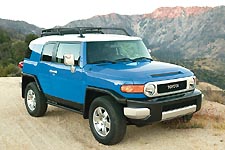Good News, Bad News
2007 Toyota FJ Cruiser
These are hard days for lovers of SUVs. With rising gas prices, global warming concerns and the political implications of dependency on foreign oil, driving the all-American sport-utility vehicle is becoming ever more vice than virtue.
Which makes the debut of the Toyota FJ Cruiser such a mixed message. How can I in good faith recommend a reasonably priced, distinctively designed and fun-to-drive vehicle when it gets less than 20 miles per gallon?
 |
Pretty easily, actually. Let’s leave aside for the moment the question of the FJ Cruiser’s thirst — I’m not here to lecture about the perils of the pump — and look at the rest of the story. It’s a pretty good one.
The FJ is one of the most distinctive SUVs to hit the road in the past few years. Initially a concept car that paid homage to Toyota’s long-running FJ40, it moved into production with few changes. Given that it looks like the Michelin Man’s long-lost sibling, it’s a love it or hate it affair.
I’m firmly in the former camp. While the old FJ40 shared its design cues with the old-time Jeep — the baseline standard for rugged, off-road vehicles — the new version’s bulging contours, odd proportions and eager headlights look more like something that just popped out of a Pokémon ball. It grabs your attention — everyone from passers-by in parking lots to the pizza delivery boy wanted to take a closer look. While my test model was black, the snazzier yellow and blue paintjobs will probably gather even more attention.
The chunky and rounded exterior theme carries to the interior. The dash feels massive, and primarily vertical, with a rounded tube accenting the top. The center panel houses the basic and easy-to-reach controls, accented with a body-colored panel insert.
Access to the rear seats comes via reverse-opening suicide doors — they provide a wide entrance, but they require opening the front doors first, which can be a bit of a bother. The fold-down rear seats increase the cargo capacity significantly, although as a mid-sized SUV it won’t carry quite as much as its larger brethren. The nubbed-rubber flooring and quick-dry seats give it a ”don’t worry about the mess” vibe the fits with the FJ’s much vaunted off-road capabilities.
 |
Unfortunately, I had to take a pass a testing those off-road capabilities, given that my neighbors would have been highly likely to involve the police. And, to be honest, those capabilities are mostly there to fulfill the idle daydreams of suburban road warriors.
On the road, however, the FJ Cruiser brings a surprising level of comfort and handling. You won’t be running any asphalt slaloms, but turns feel tighter than you might expect and the ride is smoother than most other off-roaders. The six-speed manual transmission was easy to shift, and the 239-horsepower V6 engine provided plenty of power for such everyday tasks as highway merges.
Take care making those merges, however, as the FJ’s rear panels create blind spots that could hide a dump truck. Things aren’t helped by the rear-mounted spare tire that creeps too far into your visual field. Using the side mirrors for most maneuvers, from lane switching to parking, is a must. If you’re uncomfortable or unskilled at depending so heavily on side mirrors, you’ll want to stay away from the FJ Cruiser.
|
Now, about that gas mileage. Toyota often gets a pass when it comes to its big, gas-hogging SUVs because the automotive behemoth is also pumping out Priuses for the ecologically minded masses. But given the ever-rising price of gas, it’s harder to give that pass. The FJ Cruiser’s gas mileage is, frankly, awful — worse even than Toyota’s land yacht, the V8-powered Sequoia. I can say that the FJ gets a touch better gas mileage than my old Jeep Wrangler — but my Jeep drinks regular gas, while the Toyota goes for premium.
Overall, the FJ Cruiser is exactly the kind of SUV I’d buy: It’s a low price for a lot of car, it looks fabulous (if you like that kind of thing), it’s versatile, and it’s a ball to drive. In fact, it’s at the top of my current list of possible replacements for the old Jeep. I just hope Toyota gets around to improving those mileage numbers before gas prices cause a good deal to go sour.
Support Metro Weekly’s Journalism
These are challenging times for news organizations. And yet it’s crucial we stay active and provide vital resources and information to both our local readers and the world. So won’t you please take a moment and consider supporting Metro Weekly with a membership? For as little as $5 a month, you can help ensure Metro Weekly magazine and MetroWeekly.com remain free, viable resources as we provide the best, most diverse, culturally-resonant LGBTQ coverage in both the D.C. region and around the world. Memberships come with exclusive perks and discounts, your own personal digital delivery of each week’s magazine (and an archive), access to our Member's Lounge when it launches this fall, and exclusive members-only items like Metro Weekly Membership Mugs and Tote Bags! Check out all our membership levels here and please join us today!



















